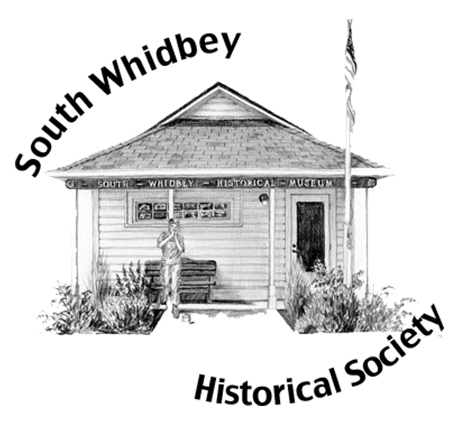About the same time that Joseph Brown was establishing a lighthouse, starting a family and dreaming dreams about founding a town on South Whidbey’s eastern coast, a San Francisco company also was dreaming large dreams about the same general area.
In 1864 the firm of Amos, Phinney and Company of California started acquiring large tracts of land along the shores of Saratoga Passage. Their first acquisition was eighty-seven acres about half way between Clinton and Glendale, a land grant from the United States of America signed by Abraham Lincoln. They continued to obtain land in large blocks which took them up into what is now the Langley and Saratoga areas?
In the beginning the firm was interested primarily in South Whidbey timber to supply a Port Ludlow mill in which they owned a part interest and also to fill orders for lumber in San Francisco where their firm was based. It is obvious, however, that they also placed a value on waterfront as their first land acquisition included over thirteen hundred feet of waterfront measured along the meander line. It further appears that they also envisioned a profitable business in platting and selling logged off land to San Franciscans who were seeking either investment or homesites. In 1866 they sold a parcel of land for $20,000 to William and Sarah Bourn and John S. Doe (this is the name listed on the deed and the signature given). The deed of sale for this property was first acknowledged by a notary public but had to be rewritten and acknowledged by the land commissioner of Washington Territory before it could be placed on file.
The firm of Amos, Phinney and Company consisted of Zachariah Amos, Arthur Phinney and William H. Hooke, attorney for the firm. According to the records Arthur Phinney decided to launch into the real estate business independently of the firm. On March 3, 1871 William and Sarah Bourn and Bartlett and J. S. Doe sold the property they had purchased from the firm to Arthur Phinney as an individual. The selling price was $10,000. The records are not entirely clear but it appears that Phinney then sold the property to Cyrus Walker for $12,500. Apparently the property was transferred back and forth between Phinney and Walker for about three years with Walker finally quit claiming his purchase back to Phinney for just what he paid for it.
In 1877 Arthur Phinney died leaving a will which, after considerable legal juggling turned his property over to his brother, John G. Phinney of Port Ludlow. Neither Arthur nor John Phinney was married and the distant heirs of Arthur Phinney were scattered around the east cost so the process of getting each to sign off was long and complicated before the title to the land finally was cleared.
John Phinney moved from Port Ludlow onto his South Whidbey property and started the beginnings of a village, including a post office. He also started dealing in real estate and one of his more notable sales was that of one hundred twenty acres to Jacob Anthes in 1881 for one hundred dollars. This later became a part of the town of Langley.
Phinney’s real estate dealings became somewhat involved so he mortgaged portions of his property to C. V. Anderson on March 16, 1885 to secure a two hundred dollar loan at two percent interest. In April, 1887 he executed a mortgage to Daniel Finch for one thousand dollars and on June 24, 1885 he filed homestead exemption on his property.
Early in 1895 Phinney disappeared mysteriously leaving his business unattended, and no trace what had happened. A petition was filed in Island County Superior Court by Francis J. Burns of Seattle asking that he be declared administrator of Phinney’s estate. The petition included the following statement:
John Phinney was last seen on, or about, February 19, 1895 at the town of Phinney two miles south of the town of Clinton; that the deceased (he was presumed to be dead) left no will and was the owner of real property in Island County and Jefferson County, the probable value of which was $15,000, and that his heirs, a brother, four sisters and assorted nieces and nephews have not presented a petition for letters of administration within the proscribed forty days after death and therefore the said Francis J. Burns should be appointed by the court as administrator.
The court appointed C. T. Terry, William B. Engle and Albert Kellogg,
all of Coupeville, as appraisers. They placed a value of $2,318.96 on Phinney’s Island County property. Apparently no one claimed the property for several years and the taxes remained unpaid until February 15, 1906 when the waterfront tract of 44 acres was sold by the sheriff to A. J. McMillan for delinquent taxes in the amount of $38.64 plus charges of $24.75.
The official record of John Phinney ends here but speculation and rumors about what had happened to him were rife among his friends and neighbors for many years. The story which many people believe is that told by B. N. Thorsheim of Clinton. In 1935 Thorsheim was visited by a friend from Oregon, Peter Henderson who related the circumstance of the forty-four year old mystery of Phinney’s disappearance. Henderson stated that there had been trouble between Phinney and one of his hired men; a fight ensued during which Phinney was killed. The murderer then fled to Oregon and was personally known to Henderson to whom he told the account of Phinney’s death. Henderson declined to name him or to reveal how he had disposed of Phinney’s body.
The town which Phinney had started gradually disappeared as its functions were taken over by the rapidly developing village of Clinton.
